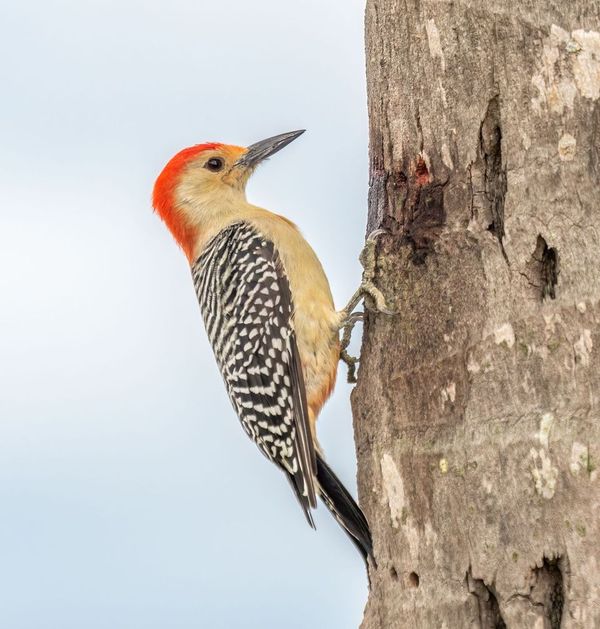
As we get into the cooler months there are many birds that have flown south for the winter. Woodpeckers, however, are one group of birds we have locally whose residence does not change much throughout the year. Regionally, we have seven woodpecker species, six of which you can easily find all year long. These woodpeckers are diverse in their characteristics and can be quite easy to attract to your yard.
Downy Woodpeckers are one of the most common woodpeckers we have. They are also the smallest, about the size of a suet cake. Downy Woodpeckers are small, black and white, and have a short bill relative to other woodpeckers. Downy woodpeckers, like most local species, are sexually dimorphic, meaning you can tell the difference between the male and female. Female Downy Woodpeckers are completely black and white, while males will have a red patch on the back of their heads. They are often heard in backyards and in woods giving their call, which is most often described as a “descending whinny.”
Similar to the Downy Woodpecker is the Hairy Woodpecker. Hairy Woodpeckers look like a larger version of the Downy Woodpecker. Hairy Woodpeckers are black and white in color like the Downy and males and females also have the same color differences as the Downy Woodpecker. The females are just black and white while the males have a red patch on the back of their heads. Hairy Woodpeckers have a larger body than the Downy, and they also have a much larger bill. They are known for their straight, upright posture which is easily seen when they are climbing tree trunks.
Red-bellied Woodpecker is another common species we have in the area. Despite their name, they have a light-colored, tan breast and a black-and-white striped back. The males have a red patch that stretches from their bill to the back of their head and the females have just a small red patch on the back of their head. Red-bellied Woodpeckers are also quite vocal! They have a very distinctive call that you can hear year-round while walking through the woods and in your yard which is often described as a shrill, rolling “kwirr.” The Red-bellied Woodpecker are also slowly expanding their range and are now found in places they historically weren’t fifty to sixty years ago.
Northern Flickers are similar in size to Red-bellied woodpeckers, but they are light brown in color and have a polka dotted breast. They are often seen on the ground “flicking” away debris to find their preferred food of ants and beetles. While in flight, flickers have a very characteristic white rump patch, and a yellow wash on the underside of their flight feathers which is very visible while in flight. The Eastern population of Flickers are called “Yellow-shafted Flickers” due to this wash underneath their feathers. On the west coast, Flickers have a red wash on the underside of their feathers and are called “Red-shafted Flickers.”
Red-headed Woodpeckers are quite striking, but also now quite rare. They’ve been in a severe decline, most likely due to habitat loss and changes in food availability. That being said, they can still be found locally in certain areas. Red-headed Woodpeckers have a bright red head, white body, and black wings. They don’t have the traditional patterning most of our local woodpeckers exhibit.
Pileated Woodpeckers are the largest woodpecker that can be found in the United States. This striking bird has a bright red crest and was the inspiration to the “Woody Woodpecker” character. The Pileated Woodpecker can reach sixteen inches in length, and they have a call that resonates easily through the woods. They make rectangular holes in trees while foraging and excavating nesting sites. These holes will often get reused by other cavity nesting birds and mammals.
We have one species of migratory woodpecker, called the Yellow-bellied Sapsucker that is found locally. Size-wise, they are in between the Downy and Hairy Woodpeckers. They can be identified by their red foreheads and will usually have a yellowish wash on their belly. They leave their characteristic mark on trees—straight lines of small round holes. These holes will leak sap and attract insects, both of which are food items for this woodpecker.
Woodpeckers can be quite easy to attract to your backyard. They are cavity nesters, meaning they will nest in hollow trees and bird houses. They forage on trees looking for insects quite readily and will also come to bird feeders quite often. The one type of food woodpeckers prefer is suet. Suet most often comes in small squares that can easily fit into a small, caged suet feeder. To attract the most woodpecker diversity, a suet feeder with a “paddletail” feature is always best. Paddletail suet feeders provide a projection under the feeder the woodpeckers can use to prop their tail feathers on. They will use their tail feathers to stabilize themselves when feeding so this feature is especially useful to large woodpeckers. Woodpeckers will also readily eat peanuts and sunflower seeds, so you may already have them coming to your existing bird feeders. No matter what food you decide to use, there is a nice diversity of woodpeckers that you can attract all year long.
Liz Magnanti is co-owner of the Bird House in Brighton.
Views: 38




